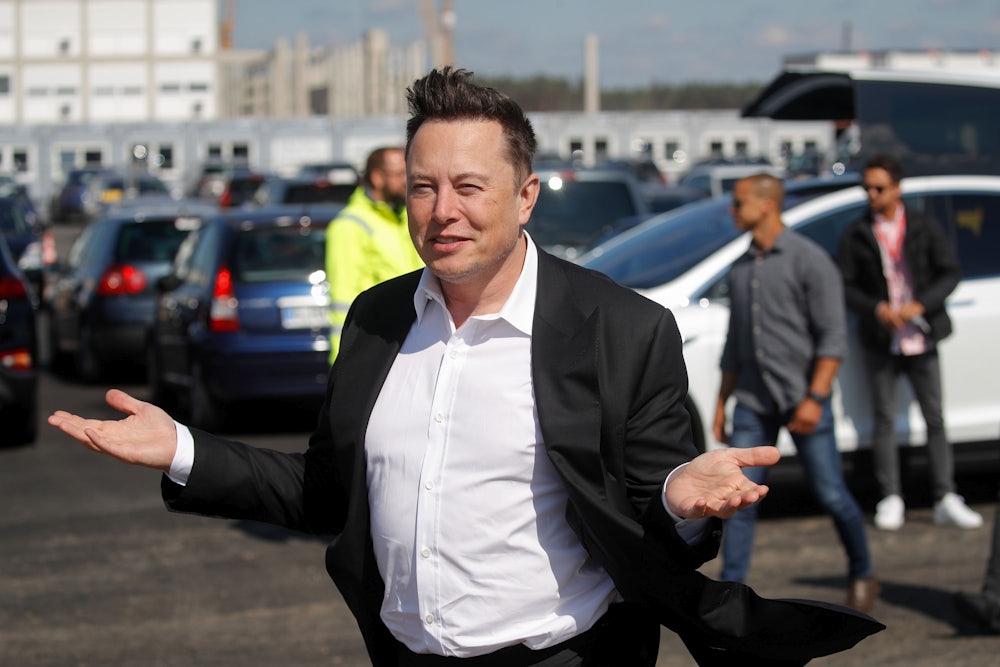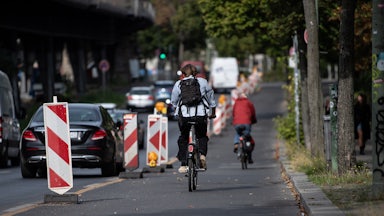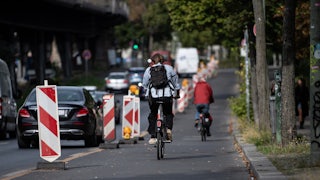Walking along the narrow shoulder of a busy road in Brandenburg State—about twenty miles outside of Berlin—you’d be hard-pressed to know you’re looking at what many consider the future of capitalism. Every so often, bright red buses whip around the bend as they ferry workers to and from the expansive, rapidly-growing campus of a Tesla “Gigafactory,” the company’s European mothership now reportedly churning out as many as 1,000 electric cars a week. The buses, however, run on diesel.
The campus, known as “Giga Berlin,” spans the length of some 60 soccer fields. It’s on the frontlines of something climate advocates in the U.S. might envy amid our still sluggish progress on climate (Inflation Reduction Act gains notwithstanding): green industrial policy. Germany is betting that it can be a global leader in the energy transition, and use its sizable manufacturing footprint as a base for building a cutting-edge clean energy sector.
The people living alongside this growing clean energy sector are a little more ambivalent: They want to take on the climate crisis, too. But they also want a say in how it happens.
For the last few years, Brandenburg has been in the midst of a devastating drought fueled by rising temperatures. The local water supplier now limits usage for newcomers to 105 liters per person per day; current residents will face that restriction starting in 2025. Just two years ago, the sprawling Tesla campus in the town of Grünheide (“Green Heath”) was a vast artificial forest of single-species patches of trees, planted as the expansion of Berlin ate up the older varieties that used to occupy the area’s sandy soil. Dry conditions are also combustible ones, and younger trees—unaccompanied by the smaller shrubs found in naturally-occurring forest that can shield the ground from the sun’s warming rays—are more likely to catch fire, a problem exacerbated by global warming. As of July, Brandenberg had lost 680 hectares of forest to 260 wildfires this year alone.
Tesla presents itself as a solution to such problems, working to decarbonize car travel one streamlined sports car at a time. For Steffan Schorcht—a resident of nearby Erkner, who’s been active in the Grünheide Citizens’ Initiative opposing the factory—Tesla is making them worse. As his group points out, the Tesla site is remarkably thirsty. In one of several lawsuits brought against the company, environmental groups have argued that the factory’s demand for 1.4 million cubic meters of water per day (enough to quench 30,000 people) will place an unbearable strain on the area’s already stretched water supplies, and could threaten the quality of area’s drinking water. Tesla CEO Elon Musk responded characteristically on Twitter, saying “We’re not in a desert.”
Beyond water issues are a host of other concerns. The site’s paint shop was found to have leaked 15,000 liters of paint mixture, although the State Environment Agency says sewage and groundwater were unaffected. The area’s roads and railways are also already under considerable strain, Schorcht says, and may not be able to handle much more.
To build its Gigafactory, Tesla has steamrolled through Germany’s notoriously extensive red tape, erecting a fully operational facility in just 22 months. It opened in March of this year with a ceremony that featured Prime Minister Olaf Scholz, of the Social Democratic Party. Tesla is currently constructing another wing on the same grounds to produce battery cells used in Tesla cars on-site; residents and environmental groups filed more than 800 objections to the expansion. The project fits in well, however, with the government’s approach to green industrial policy, focused as it is on keeping the country’s most important sectors intact—from cars to chemicals, steel, and concrete. A new scheme scheduled to begin later this year in this vein, called carbon contracts for difference, will see the government subsidize the additional cost of typically emissions-intensive industrial products produced via green methods, so as to make them cost-competitive in global markets.
“The main narrative when we look at decarbonization is, ‘Let’s keep as much of our industrial base as possible and try to decarbonize it. If possible, grow the industrial base into new fields,” said Janek Steitz, a fellow at the German think tank Dezernat Zukunft. “It’s almost like an invisible agreement between industry groups, labor unions, and the government that the industrial base is supposed to stay as is.”
This approach could benefit the states of former East Germany, which have lagged behind the West economically since reunification and the blunt force privatization process that followed. Volkswagen, BMW, and the Chinese company CATL have have opened facilities in Zwickau, Dresden, Leipzig, and Amt Wachsenburg, in Thuringia, thanks in part to a slew of incentives from the federal government and European Commission. Of the 323,000 electric vehicles Germany produced last year, 57 percent were made at Volkswagon facilities in the East, far from its legendary home base in Wolfsburg. The extra space and lower wages are an added bonus for companies building new facilities in the East, as is the more easy availability of renewable energy in the country’s traditionally less-developed north and south. Tesla hopes to build a research and development site in Berlin, where it can attract a young international workforce to the “poor but sexy” city.
While the East’s manufacturing renaissance promises plenty of jobs for more depressed areas—the Gigafactory alone aims to employ 12,000—some residents close to the project want a say in how it happens. The Citizens’ Initiative Schorcht formed, was in part, shortly after Tesla held an informational session in Erkner in December 2019. “One result of this event was the realization that, ‘We have to do something!’” Schorcht told me over email. The group now has about 30 active members who have pored over Tesla permits and planning documents, all in coordination with local environmental groups mounting legal challenges.
“All these planning processes are learning processes as well,” he said. At issue are what critics call the “salami tactics” Tesla has used to start construction: As Schorcht puts it, “Every plan reveals another slice. It’s never clear what the final project will look like.” The facility was constructed bit by bit using a series of provisional permits, essentially betting that authorities wouldn’t intervene to stop construction if it had already started. That included a green-light allowing the company to build despite the area’s status as a water protection area.
“What’s missing here is any opportunity for democratic participation. We’re not against industrial development,” Schorcht says. He notes that other industries building nearby—a logistics facility and a cement plant—have had more congenial relationships with their neighbors. “But in this case no democratic participation was possible,” he adds. “There should have been a more democratic process where the whole community could have deliberated the context and made a development plan for how to create an industrial site here.”
Politicians haven’t been especially helpful, said Schorcht, who isn’t a member of any party. Brandenburg State—where many of the key decisions around the factory have been made—is governed by a coalition between the Social Democratic Party, the Green Party, and the Christian Democrats. Jörg Steinbach, Brandenburg’s SPD economy minister, has been among the most enthusiastic boosters for enticing Tesla to the region, and Schorcht says the party as a whole has been “totally uncritical” of the project. SPD economics minister Robert Habeck, for his part, praised the “Tesla Tempo” at which the Gigafactory was built. Asked how local and state-level politicians have responded to the group’s concerns, Schorcht says, “Often not at all, and, if so, too slowly and largely incompetently.”
Shortly after local residents began raising concerns, Schorcht said, members of the far right party Alternative fur Deutschland began showing up to their demonstrations, “which delegitimized the whole initiative.” The AfD enjoys considerable support in Brandenburg. Regional elections there in 2019 saw the party double its vote share, coming in second place with 24 percent. Schorcht thinks it’s likely they could gain votes by protesting Tesla, noting that they’ve raised fears about an influx of Polish workers and other migrants.
The Citizens Initiative went to great lengths to distance itself from the AfD after the party took an interest in their fight. One step the group took was reaching out to left-leaning climate outfits like Ende Gelände, which has fought lignite coal mining by (among other tactics) occupying mining sites. “In the end we could reclaim our legitimacy,” he said. “The idea that we were close to the AfD is not present anymore.” The group has also built ties to activists resisting a proposed lithium mining project in Serbia being spearheaded by the Canadian firm Rio Tinto. The result is a more comprehensive opposition to the entire electric vehicle supply chain and the government’s approach to industrial policy, with its emphasis on greening what’s already there.
Ultimately, he’d like to see more mass transit built up, and is weary of tying the decarbonization of the country’s transportation sector to luxury vehicles. “There is no one solution. Our goal should be that, with reduced resource and energy consumption and more sustainability, climate change is slowed down and reversed as much as possible,” Schorcht says. “The best and most ideas come from below. Stopping climate change can only be achieved with the democratic participation of the people.” Pushing climate policy with the promise of green jobs and industrial dynamism—as many leaders, including President Biden, seem set on—is easier said than done.










